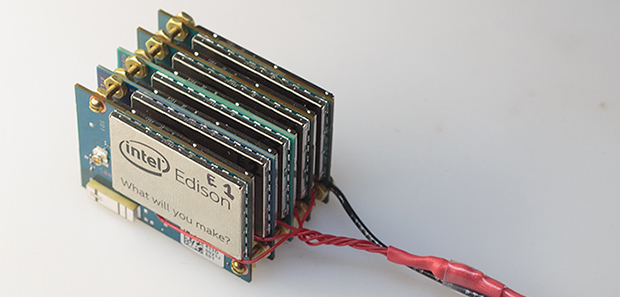The Intel Edison is an incredibly small and cheap x86 computing platform, and with that comes the obvious applications for robotics and wearable computing. [mz] had another idea: what if the Edison could do work that is usually done by workstations? Would it make economic sense to buy a handful of Edisons over a single quad-core Xeon system?
[mz] thought the Edison would be an ideal platform for fuzz testing, or sending random, automated data at a program or system to figure out if they’ll misbehave in interesting ways. After figuring out where to solder power and ground wires to boot an Edison without a breakout board, [mz] got to work benchmarking his fuzz testing setup.
Comparing the benchmarks of a fuzzing job running on the Edison and a few servers and workstations, calculations of cost-efficiency worked out well for this tiny x86 system on module. For parallelizable tasks, the Edison is about 8x less powerful than a reasonably modern server, but it’s also about 5-8x cheaper than a comparable desktop machine. Although renting a server is by far the more economic solution for getting a lot of computing power easily, there are a few use cases where a cluster of Edisons in your pocket would make sense.
















FTA – “I first had to solder the DF40 connector – I’m pretty sure that’s what it feels to be a brain surgeon”
The SEO shills were telling us those plugs would be DIY friendly.
Fuzzing usually requires precision timing to reproduce the exploits.
A low power CPU would essentially be a probabalictic bug generator.
probabilictic
probabilistic <- win
LOL
Well, the plugs are about a dollar apiece, and if you have a toaster oven you don’t want to use for food anymore…
As far as connectors go, Intel could have done much, much worse.
it would be interesting to see how this compared with the parallella board
http://www.parallella.org/2014/06/03/my-name-is-brian-and-i-build-supercomputers-in-my-spare-time/
Testing workloads aren’t exactly the sort of thing that is tremendously “parallelizable” by the parallella. It’s aimed mostly at large-scale DSP type stuff. Not general purpose branchy code.
Pretty nice, even if it is not as powerful and econimical, who can say to hold that amount of calculation power on the palm of your hand?
Another side not, you have to have something to calculate on this dense box of calculation wizardy…
if you can afford to buy 5 of these why not simply make PCBs for them?
Because a PCB wouldn’t help him make a pretty stack of boards
two words – used laptop
and only if you really need x86, otherwise any ARM quad core board will eat this piece of intel crap
Old Quad core ARM based cell phones are cheap and getting cheaper. You get a free hi-rez LCD screen and BUILT IN UPS!
Cell phones don’t have many easy to use interfaces, though.
You need a pretty good laptop to replace a stack of 8 of these boards. And if you mean to replace a single board by a used laptop, then it’s not really any more convenient.
What, quad core xeon? That’s what you get if ýou buy 10 year old 4P machines or really lame C2D stuff. Nowadays good xeon machines have 20++ cores and go up to 80 or even 144 cores if you consider 8P machines and and the new 18 core E7-V3. ARM will bite hard on this, if they want to compete in performance.
The SoC is heavily underclocked so it doesn’t need much of a heatsink. Every “fast” Arm board I’ve seen hits thermal throttling in 30secs of hard work, including phones, also nothing I’ve seen beats this on size. I’m looking forward to mine arriving. Not sure I’m going to enjoy systemd though. Hope I can reflash it with a more traditional init.
Zapparella is what he meant and hope the layoffs don’t get that dude, he s doing interesting stuff